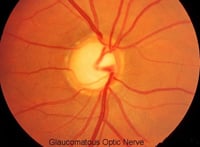Exercise with Some Limits is Believed to be Beneficial for Glaucoma Patients
In most cases exercise is good for glaucoma patients if performed properly. Although there are a few exceptions, some research supports the benefits of moderate exercise for glaucoma patients. The exercise should be moderate and not extreme since there is now research showing extreme exercise creates large amounts of free radicals within the body, which can have its own set of problems.
 Current treatment for glaucoma strives to lower intraocular fluid pressure (IOP) within the eye using eye drop medicine, laser procedures or specialized glaucoma procedures. Lowering the IOP helps maintain the health and integrity of the optic nerve. Glaucoma is a disease of the optic nerve and anything that helps the optic nerve can help a glaucoma patient. The optic nerve requires sufficient blood flow to maintain proper function and avoid neuronal degeneration. Poor blood circulation or low blood pressure can create damage to the optic nerve especially when the IOP is high. Therefore, anything a glaucoma patient can do to improve circulation can aid the health of the optic nerve.
Current treatment for glaucoma strives to lower intraocular fluid pressure (IOP) within the eye using eye drop medicine, laser procedures or specialized glaucoma procedures. Lowering the IOP helps maintain the health and integrity of the optic nerve. Glaucoma is a disease of the optic nerve and anything that helps the optic nerve can help a glaucoma patient. The optic nerve requires sufficient blood flow to maintain proper function and avoid neuronal degeneration. Poor blood circulation or low blood pressure can create damage to the optic nerve especially when the IOP is high. Therefore, anything a glaucoma patient can do to improve circulation can aid the health of the optic nerve.
In general, exercise tends to lower IOP and certainly improves blood circulation. So, if you have glaucoma or are one of the millions of Americans that are glaucoma suspects, try moderate exercise!
Exercise Guidelines for Glaucoma Patients
- Exhale during periods of maximum exertion such as when lifting
 weights. Inhale when lowering the weight. This will help you avoid the Valsalva effect, which is when a person exhales forcefully with a closed mouth or held nose and the windpipe is blocked by the closed epiglottis. The Valsalva effect can increase pressure dramatically sometimes up to 300% of the normal IOP. The same also applies to playing a musical wind instrument, which can substantially raise IOP.
weights. Inhale when lowering the weight. This will help you avoid the Valsalva effect, which is when a person exhales forcefully with a closed mouth or held nose and the windpipe is blocked by the closed epiglottis. The Valsalva effect can increase pressure dramatically sometimes up to 300% of the normal IOP. The same also applies to playing a musical wind instrument, which can substantially raise IOP. - Yoga and Pilates participants must be extremely careful and will need to limit their scope of movements. Holding breath going into or out of a pose raises IOP significantly.
- Avoid all inverted positions including headstands and inversions for back relief, etc. since all inverted positions raise IOP substantially.
The long term effect of exercise on glaucoma progression is not known, but anything that improves overall health and helps in maintaining the integrity of the optic nerve is a positive benefit.

 weights. Inhale when lowering the weight. This will help you avoid the Valsalva effect, which is when a person exhales forcefully with a closed mouth or held nose and the windpipe is blocked by the closed epiglottis. The Valsalva effect can increase pressure dramatically sometimes up to 300% of the normal IOP. The same also applies to playing a musical wind instrument, which can substantially raise IOP.
weights. Inhale when lowering the weight. This will help you avoid the Valsalva effect, which is when a person exhales forcefully with a closed mouth or held nose and the windpipe is blocked by the closed epiglottis. The Valsalva effect can increase pressure dramatically sometimes up to 300% of the normal IOP. The same also applies to playing a musical wind instrument, which can substantially raise IOP.